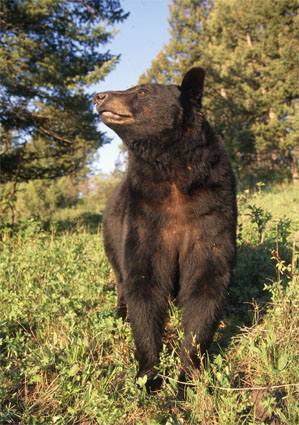 The size of paw tracks, bear bed depressions, claw marks, and dung will tell you if there’s a big bruin nearby. |
Americans have been enthralled with hunting black bears ever since Davy Crockett killed “hiself a bar when he was only three.” But settling your sights on a better-than-average specimen, a fall bruin that tips the scales at 300 pounds or better, is not so an easy task even for Davy. What is the secret to success? You have to interpret the sign these big bears leave behind correctly. Here are four clues that point to the whereabouts of a book bruin.
TRACKS
Generally, a black bear with a front pad measuring five or more inches across is a boar, and a candidate for the Pope & Young Club. But stumbling upon a big track is no guarantee you will ever see that bear again…unless he is regularly frequenting a nearby food source. A big boar will put his paws in the same place each time he visits the site, eventually leaving a trail of pie-plate size impressions on the ground. A big male will also slowly step over a log leaving a front footprint near its edge whereas sows will step six inches to a foot past the log in their haste to get to the goodies.
BEAR TRAILS
Boars are super-cautious when they eat and will often circle an old apple orchard or man-made bait pile before committing themselves to the setup. Why? The last thing they want now is a close encounter with a bigger male for surely a brawl will ensue. Look for a faint trail that lies just within sight of the food source. You may have to get down on your hands and knees and examine the forest duff carefully, but locating such sign separates the casual bear hunter from the real experts. A depression in the leaves will indicate where the bear lay down to keep tabs on the site until near dark, giving you yet another clue as to his body size. Indeed, pay close attention to any bear bed exceeding 40 inches in length.
BEAR DROPPINGS
Bear poop can also indicate a bear’s body size. A coil the diameter of a soft drink can, for example, indicates a mature boar’s presence. Again, no guarantee you will ever see this bruin, but when droppings are deposited on a trail leading to a food source, it usually indicates the boar is laying claim to the site. It may take two to four days before the boar returns, and even so it may be under the cover of darkness. Try depositing dung from another bear on the same trail, and see if the challenge pays off with an early sighting.
BEAR CLAWS
Big bears do not climb trees! Don’t be fooled by this old wives’ tale. Giant bears often climb aspen trees in the spring, and cherry and beech trees in the fall to feed, as evidenced by claw markings six to eight inches in width escalating vertically along the tree’s trunk. Average bears leave markings half that in width. If the scars are fresh and there is still food in the tree, he’ll be back.






